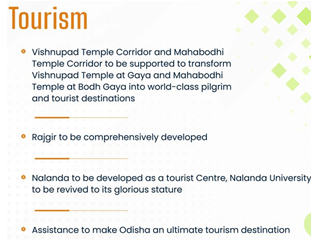

24TH July 2024 (14 Topics)
Context
The Union Budget 2024 has marked a significant shift towards promoting tourism in Bihar and Odisha, highlighting these states' cultural richness and potential for economic development. This move aligns with the government's broader strategy of regional development under the 'Purvodaya' plan, aimed at transforming the eastern region of India into a hub of growth and cultural heritage.
What is 'Purvodaya' Plan?
- The 'Purvodaya' plan targets holistic development across Bihar, Jharkhand, West Bengal, Odisha, and Andhra Pradesh.
- To propel these states as engines of development, it emphasizes:
- human resource development
- infrastructure enhancement
- economic opportunities
- Tourism Strategy: The shift from circuit-based to destination-based tourism signifies a focused approach towards developing specific tourist destinations. This includes upgrading tourist facilities, improving connectivity, and boosting local economies through tourism-related activities.
Focus on Bihar and Odisha:
- Tourism Development: Bihar and Odisha have been identified for comprehensive tourism development initiatives. The focus includes enhancing infrastructure, connectivity, and tourist facilities at key heritage sites like the
- Vishnupad temple in Gaya
- Mahabodhi temple in Bodhgaya (Bihar)
- and various cultural and natural attractions in Odisha
- A new temple corridor will be constructed for Vishnupad at Gaya. Similarly, a new corridor will be built for Mahabodhi temple corridor at Bodh Gaya. Both the corridors will be supported and modelled on the Kashi Vishwanath temple
- On the same lines, a comprehensive development scheme has been announced for Rajgir. Rajgir has immense spiritual significance for Hindus, Buddhists and Jains.
- Nalanda in Bihar will be developed as tourist destination.
Fact Box: Key-Locations
§ Rajyatana Tree: Marked as the site where Buddha spent the Seventh Week.
|
More Articles


